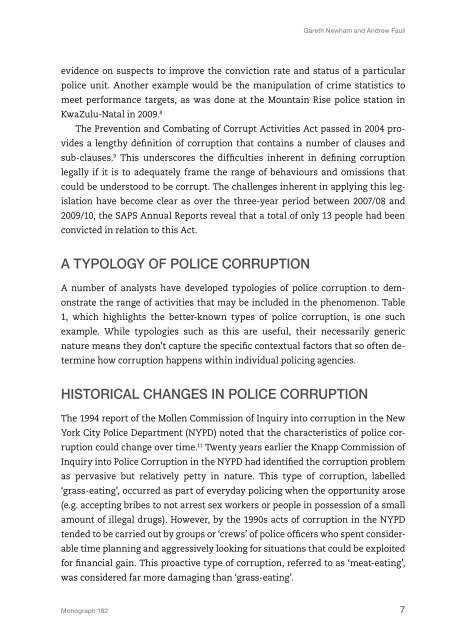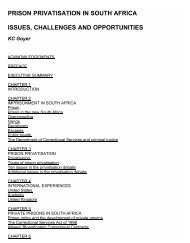Protector or predator? - Institute for Security Studies
Protector or predator? - Institute for Security Studies
Protector or predator? - Institute for Security Studies
Create successful ePaper yourself
Turn your PDF publications into a flip-book with our unique Google optimized e-Paper software.
Gareth Newham and Andrew Faull<br />
evidence on suspects to improve the conviction rate and status of a particular<br />
police unit. Another example would be the manipulation of crime statistics to<br />
meet perf<strong>or</strong>mance targets, as was done at the Mountain Rise police station in<br />
KwaZulu-Natal in 2009. 8<br />
The Prevention and Combating of C<strong>or</strong>rupt Activities Act passed in 2004 provides<br />
a lengthy definition of c<strong>or</strong>ruption that contains a number of clauses and<br />
sub-clauses. 9 This undersc<strong>or</strong>es the difficulties inherent in defining c<strong>or</strong>ruption<br />
legally if it is to adequately frame the range of behaviours and omissions that<br />
could be understood to be c<strong>or</strong>rupt. The challenges inherent in applying this legislation<br />
have become clear as over the three-year period between 2007/08 and<br />
2009/10, the SAPS Annual Rep<strong>or</strong>ts reveal that a total of only 13 people had been<br />
convicted in relation to this Act.<br />
A tyPOlOGy of poliCE c<strong>or</strong>rUPTiON<br />
A number of analysts have developed typologies of police c<strong>or</strong>ruption to demonstrate<br />
the range of activities that may be included in the phenomenon. Table<br />
1, which highlights the better-known types of police c<strong>or</strong>ruption, is one such<br />
example. While typologies such as this are useful, their necessarily generic<br />
nature means they don’t capture the specific contextual fact<strong>or</strong>s that so often determine<br />
how c<strong>or</strong>ruption happens within individual policing agencies.<br />
HiSTOriCAl changes in poliCE c<strong>or</strong>rUPTiON<br />
The 1994 rep<strong>or</strong>t of the Mollen Commission of Inquiry into c<strong>or</strong>ruption in the New<br />
Y<strong>or</strong>k City Police Department (NYPD) noted that the characteristics of police c<strong>or</strong>ruption<br />
could change over time. 11 Twenty years earlier the Knapp Commission of<br />
Inquiry into Police C<strong>or</strong>ruption in the NYPD had identified the c<strong>or</strong>ruption problem<br />
as pervasive but relatively petty in nature. This type of c<strong>or</strong>ruption, labelled<br />
‘grass-eating’, occurred as part of everyday policing when the opp<strong>or</strong>tunity arose<br />
(e.g. accepting bribes to not arrest sex w<strong>or</strong>kers <strong>or</strong> people in possession of a small<br />
amount of illegal drugs). However, by the 1990s acts of c<strong>or</strong>ruption in the NYPD<br />
tended to be carried out by groups <strong>or</strong> ‘crews’ of police officers who spent considerable<br />
time planning and aggressively looking f<strong>or</strong> situations that could be exploited<br />
f<strong>or</strong> financial gain. This proactive type of c<strong>or</strong>ruption, referred to as ‘meat-eating’,<br />
was considered far m<strong>or</strong>e damaging than ‘grass-eating’.<br />
Monograph 182 7

















